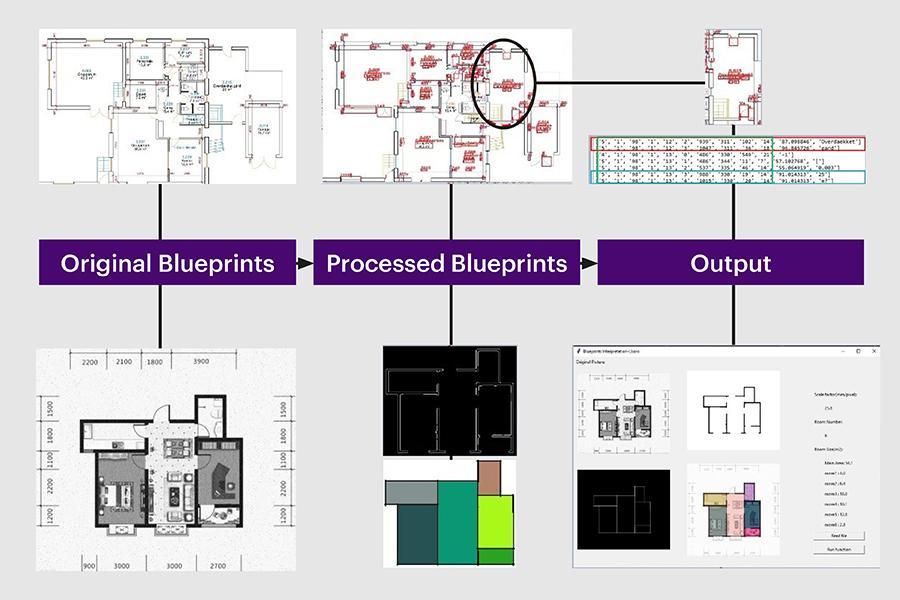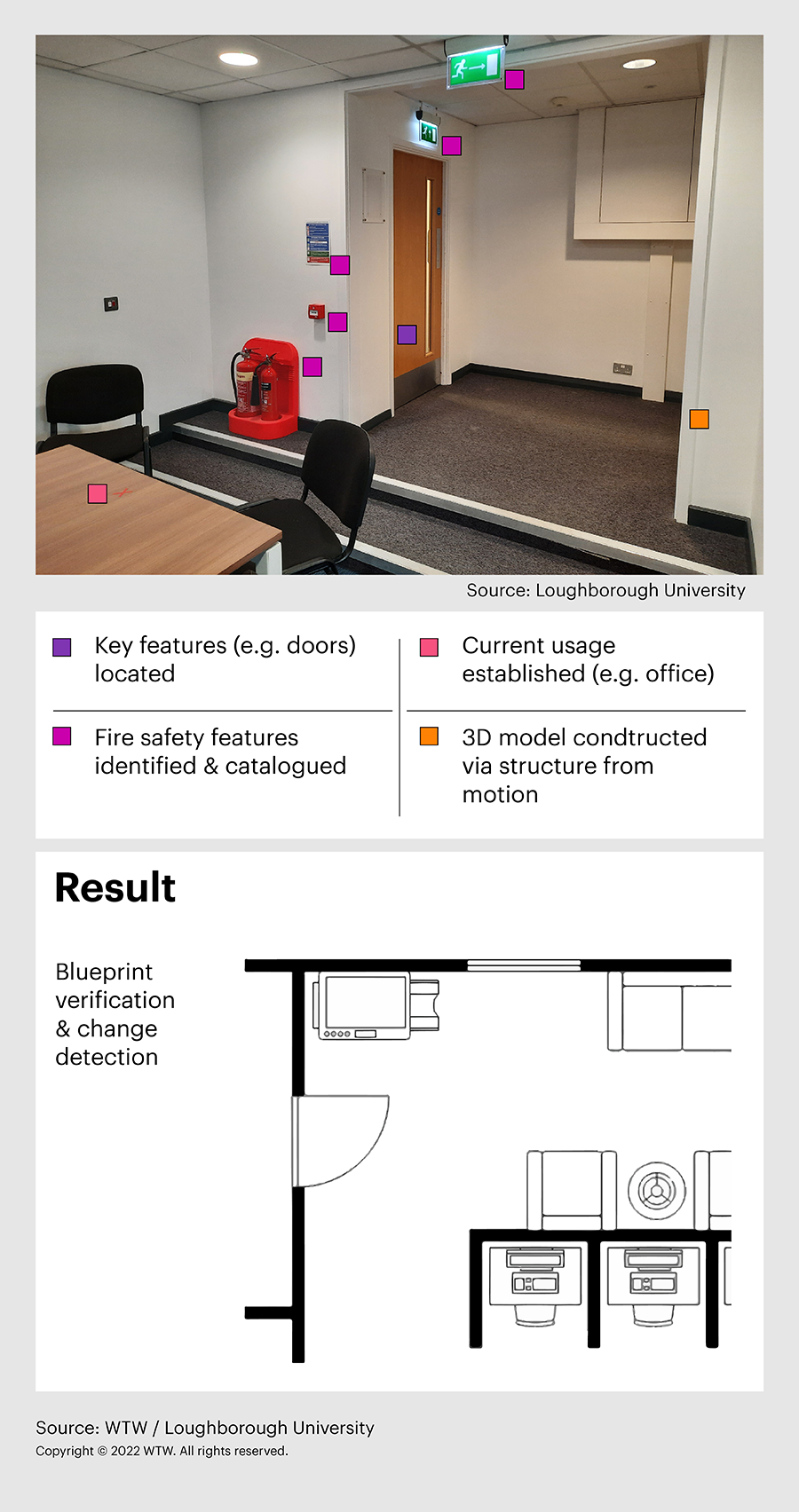Is this an area of insurance ripe for digital assistance? If so, what will be the impact on clients, brokers and underwriters?
Risk assessments for industrial properties are conducted by risk engineers, who synthesize heterogenous information sources via a variety of methods and then use their professional expertise to communicate this information in the form of summary risk metrics. Blueprints are fundamental to this, showing the layout of industrial sites and mitigation measures such as fire walls. These blueprints, particularly for older properties, are typically only available on paper or as pdf documents. A considerable amount of the risk engineer’s time and effort is involved in extracting key information from these blueprints.
As a response to this industry-wide challenge the WTW Research Network sponsored research on use of digital tools for automated extraction of blueprint information. The potential is obvious. Such digitization could reduce much of the routine work of risk engineers, allowing them to focus on where they add most value, using their experience and skills to make the professional judgements of potential loss on which the terms of insurance policies are based.
Digitization could also lead to more effective and standardized sharing of information on exposures and vulnerability, in turn helping address some of the substantial frictions that increase premiums and limit available coverage. Yet, realizing this potential requires harnessing and integrating currently available technologies.
Loughborough University conducted an initial investigation into the use of machine learning tools, commonly referred to as 'AI', for blueprint interpretation. This has required harnessing and integrating a number of currently available technologies (see Box 1). It has led to a good understanding of what is required for these methods to be used at scale for property risk assessment, but also highlighted the challenges of implementation.
The work at Loughborough is a pilot study using publicly available residential property blueprints and focussing as a final output on calculation of room area. This is valuable because it demonstrates that it is possible to combine and interpret graphical, locational and textual blueprint information. It also supports a natural validation of the processing since, for instance, it is possible to compare room sizes written on the blueprint with areas calculated from the walls plotted on it.
A principal insight is that there is no inherent barrier to information being automatically extracted from industrial and commercial property blueprints. This is a challenge that can be met with sufficient access to blueprints and time spent on developing the processing and training the software.
While outcome will never be 100% accurate, high levels of accuracy can be achieved provided the processed blueprints are not totally variant from those used for the software development. The key advantage is processing speed. Provided accuracy is reasonably high then these tools can provide useful practical support to risk engineers, relieving them of much routine work and leaving them with the easier task of reviewing the outputs of automated blued print interpretation.
The technical contribution of the proof of concept is in the successful application of a selected combination of machine learning. The technical tools are not themselves new, they are well established in a variety of computer vision applications including to blueprints and architectural drawings developed over the past decade – details in Chen et al. (2022). The added value is integrating the tools into a single integrated ‘end to end’ process, that begins with blueprints as inputs, extracts information in a useable form and produces analytical output.
It is well established that object recognition can employ either “one stage” neural network methods which identify bounding boxes for the various structures and objects, or “two stage” approach in which a second refinement stage is added to confirm accuracy of object identification from their “convolution” i.e. relationship to each other. The principal tool used in this proof of concept is a two stage “Convolution Neural Network” or CNN, widely used in both object detection and recognition and to optical character recognition.

Figure 1 illustrates an application of this work. The workflow follows several stages of processing (see Box). The original blueprints, in a variety of forms, are prepared and processed to extract key information, including room and building boundaries and, using Optical Character Recognition (OCR), room names and dimensions. Red highlights information that is identified, located and tabulated. The workflow quantifies the size of rooms before bringing the information together into a graphical interface.
The prospect that emerges from this work is by no means the replacement of skilled experts in insurance risk assessment. The reality is far from the media Frankenstein myth about AI growing to become more intelligent than its human creators. The prospect is the development of tools to support risk engineers and enhance their work.
Over time these tools could become very powerful. Imagine a risk engineer, able to prepare for a visit more rapidly with an AI-prepared summary of features from a blueprint. Equipped with a camera, standard features might be captured automatically, freeing their attention to the customisation of their risk assessment, focusing on the unusual, the differences from what might be expected that could be crucial in terms of a fire spreading.

Figure 2 - Figure of an idealized future outcome. A future tool might identify key features (e.g. door, fire extinguishers), and self-generate a 3D model and thus a floor plan to verify blueprints and highlight changes since construction.
We envisage further evolution of business process, building on the foundation of automated blueprint interpretation, leading to wider economic benefits. Digitisation of this kind can further support standardisation of business processes and enhance consistency of approach across individuals and firms. If practitioners adopt common approaches and these are accepted at national and industry level, this can support greater comparability of risk assessment and thus increased efficiency of risk transfer as well as reducing cost in risk assessment. Digitisation and adoption of more standardised methods can further support the development of tools of knowledge management for risk engineering, ensuring that skills and understanding are understood, shared and disseminated as widely as possible.
WTW Research Network is now working towards the launch of a joint venture, a ‘mini Centre for Doctoral Training’ pursued over the next four years in partnership with Loughborough University, which will support 6 PhD students examining foundational questions about the application of digital technologies in industrial and commercial property insurance. Our shared hope is that this initial research can be the incubation of an industry wide effort (e.g. agreed benchmarks for consistency, independently contributed open-source code, the development of operational tools) for digital transformation of risk assessment.
The planned topics of this initial research, pursued under the supervision of a team of Loughborough academics together with WTW supervisors and advisers, are:
